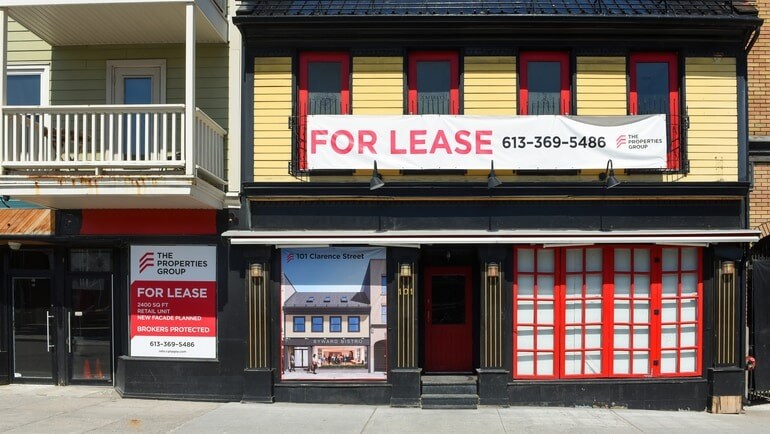Leasing a restaurant is a serious business. A restaurant lease tends to last for three to five years, and once you’re in and you’ve invested money and time into the space, there’s no turning back.
Whether you’re an enthusiastic new restaurateur ready to sign your first-ever restaurant leasing agreement, or a seasoned entrepreneur considering a new location, leasing a restaurant is one of the most important commitments you will make.
Before you sign on the dotted line, it’s important to consider your options carefully. To help you navigate the process this article will cover:
- The distinctions between buying a restaurant vs. leasing a restaurant
- How to set a budget for your restaurant lease
- Tips on researching the neighborhood to assess your location
- How to measure your space and assess its potential
- The key questions to ask when leasing a restaurant
- How to negotiate a restaurant lease when you rent a restaurant space
Here are our top five considerations to help you make the right choices and get the best deal possible.

Buying a Restaurant vs. Leasing a Restaurant
- Restaurant leasing means entering into a long-term rental agreement where you can make the space your own and you are responsible for certain maintenance and repairs as agreed.
- Buying a restaurant means purchasing restaurant real estate outright so you have complete control and you can keep it as an asset.
Buying a restaurant makes sense if you are sure that you will be successful in the long-term in that location – if you have several other outlets that perform well in similar locations, for example. If you plan to stay in the same spot for seven years or more and you are sure that the location won’t change too much over that period, buying may be the right option.
In contrast, leasing makes more sense if you are opening up a new business, if you have expansion plans, or if you are trialing a concept and may need a larger space in the near future.
While some people are drawn to the security and value of a long-term lease, others may be wary of the potential liabilities if their business doesn’t take off as they hoped.
There’s also the possibility of getting intermittent renewal options to accompany your initial lease period. This is something you can discuss during your negotiations, which we’ll get to later.
Hiring a Commercial Real Estate Agent
Leasing a restaurant is a big commitment, which is why you should always start by enlisting the help of a professional.
Before you even start looking at restaurants to lease, you should always hire a licensed and experienced Commercial Real Estate Agent as your “Tenant Rep.” These agents not only help you better understand the real estate market in your area, but they also represent you and your best interests throughout the execution of the contract. This is especially crucial as there are many legal trappings and fine print in a lease agreement that can sink your business if you don’t have an expert on your side.
Top 5 Tips for Leasing a Restaurant
Once you have a Commercial Real Estate Agent in your corner, you can begin your hunt for the perfect place. Below are our top 5 tips for finding and leasing a restaurant.
1. Set a Budget
Setting a realistic budget to work with is essential when you are assessing different spaces to lease. If you don’t have a clear idea of the costs, you won’t have a reference point for making decisions and negotiating.
If you have already written a restaurant business plan, you will be familiar with how to carry out a market analysis, in which you thoroughly research the market to determine how much revenue you could potentially bring in.
During the process, you look at similar businesses and competitors in the areas you want to open the restaurant. You can even interview business owners to get some realistic expectations.

Download this customizable restaurant business plan template to create a professional business plan for your new venture.
Once you have an idea of your projected revenue, you can figure out what you can afford to spend on rent, utility bills, and additional costs like insurance, property taxes, and maintenance costs. Typically, restaurateurs budget 5-10% of revenue on these fixed costs. Financial spreadsheets can help you keep track of all the numbers and automate calculations.
Depending on your capital assets, you can then decide how much wiggle room you can leave in your budget. Remember to leave a buffer just in case of unexpected circumstances. We can all appreciate the importance of preparing for a rainy day given the last few years.
2. Research the Neighborhood
If you’re looking at a certain neighborhood, chances are you have an idea of the foot traffic and demographics of the people who live there. But when leasing a restaurant for three to five years, it’s important to dig into the details and plan for the future.
Be patient and don’t rush this step. It could take months to properly research a neighborhood and think of all eventualities.
Is the neighborhood a well-established dining district with lots of competition, or are you moving into an up-and-coming destination where you’ll have to set the trend and bring customers to the area? Restaurant real estate prices can increase rapidly when an area becomes a dining hotspot.
It’s not just about what the neighborhood is like now. You must think about how it will change over the course of your lease. Ask yourself: what will the neighborhood look like in three years’ time? Are there any trends developing?
The key factors to dig into include:
- The competition – who are your main competitors? Are there local businesses that will complement your restaurant? For example, a gym full of fitness enthusiasts would be a great neighbor for your smoothie shop.
- Business turnover – do businesses come and go or are there a number of well-established restaurants in the area? If the street, building, or entire neighborhood has a transient business crowd, this is a major red flag.
- Foot traffic – is there enough pedestrian traffic to sustain your restaurant? Or is it more important that there are residential areas nearby for delivery orders?
- Atmosphere – make sure know the area inside out, at different times of the day, and every day of the week. Does it become a rowdy area on Friday nights? Is it a lazy Sunday spot?
- Access – is your space easy to find? Can you offer parking or, if not, is it near enough to public transport links? Think about whether it’s easy enough for your customers to find.
3. Measure Your Space
Be sure to take accurate measurements of your potential restaurant space. Agents have been known to exaggerate or sell ‘phantom space’ which can jack up the rent. Make sure you’re not paying for more space than you can actually use.
Think about how much space you need for the kitchen, bar, and back-of-house areas, as well as how much you need for dine-in customers (if any). Most restaurants allocate around 40% for service and back-of-house areas.
Obviously, this depends on the type of restaurant, with quick service restaurants requiring little customer space and fine-dining restaurants allocating up to 20 square feet per seated customer.
4. Assess the Potential of the Space
Many restaurateurs are keen to make their mark on a restaurant space, while others want to hit the ground running and start making revenue immediately. Decide what your primary goals are as you assess your restaurant lease.
Questions to Ask When Leasing a Restaurant
Here are the key questions to consider when assessing your restaurant’s potential new home:
- Can you save money by taking on a space that needs more work? In other words, do you want to lock in a low rent and then do the renovations yourself to make it as you want? Or do you need a turnkey space that is ready to go on day one?
- Look at the condition of the space. Is it up to fire and safety standards? Or does it need investment?
- Are you converting an industrial or retail space to become a restaurant? Or is it already set up to serve food? Does the kitchen need upgrades or different equipment?
- How much time and money will you need to invest to get a restaurant space customer-ready?
- Does the lease include an annual rent increase? If so, negotiate a cap on how much the landlord can increase the rent.
- Who is responsible for renovations, maintenance, property taxes, insurance, and other costs associated with the building? Make sure this is clear upfront to avoid hidden costs down the road.
- Are you allowed to sublet the lease if you need to leave early?
- Do you have the option to negotiate the terms of the lease at certain points?
- Can you negotiate a break clause so that you can get out early if things aren’t working out?
The answers to these questions should play a role in determining your budget. Make sure you know the answers before embarking on the next step: negotiating a restaurant lease.
5. How to Negotiate a Restaurant Lease
Now that you have your restaurant finances in order, you’ve completed your research, and you’ve decided the space is right for you, it’s time to get down to business. But before you sign this important contract, it’s essential to prepare for negotiations.
Some people are natural bargainers, but many people find it difficult or awkward to fight for the best deal. The problem is, if you don’t negotiate and stand up for yourself, you will be taken advantage of.
Here are some top tips to help you get over the fear and take control of the negotiations to ensure you get the best deal possible when you rent a restaurant space.
1. No one is going to negotiate for you
You can be sure that the landlord or agent will negotiate hard to get the best deal, so you better be prepared to do the same. Don’t be cautious; be bold and stand up for yourself. Get your head around the finances, know your budget and how far you’re prepared to stretch it, then go out and get the best deal you can.
2. Be prepared to walk away
This is easier said than done, especially if you have fallen in love with a space and started imagining your future success there. But it’s crucial to remain rational and not clouded by emotions if the deal is not right for you.
3. Ask for more than you need – leave wiggle room
Always ask for more than you ideally want, so there’s room for a little negotiation and compromise. You can be sure the other side won’t accept your first offer.
4. Talk to other tenants
If you can, have a chat with other tenants in the building to get an idea of what the landlord is really like. Ask plenty of questions about the reality of leasing from the landlord.
5. Never accept the first offer
It can be tempting to rush to get the deal done if the initial offer seems reasonable. But the agent will always leave wiggle room, just as you have, so you should always come back with a counter-offer.
6. Take your time
You’ve spent months carefully deciding on a budget, researching the neighborhood and the restaurant space, there’s no need to rush into signing a restaurant lease at this stage. Always think your decisions through carefully, consult with friends and colleagues, and then take your time in making the next move.
7. If in doubt, hire a professional
A qualified real estate attorney will comb through your lease for any potential red flags to make sure you’re signing off on the best possible lease terms. The upfront investment is likely to pay in the long run if you can negotiate better terms over a multi-year restaurant lease.
Without wanting to put too fine a point on it, leasing a restaurant is one of the most important commitments you will make.
While you don’t want to dilly-dally and create unnecessary delays, it’s important to give enough time for budgeting, assessing potential spaces, and negotiating to get the best deal possible.
Putting the right foundations in place at this stage will save you time, money, and hassle in the long run. Your restaurant’s success depends on it.
Download our free inventory template







